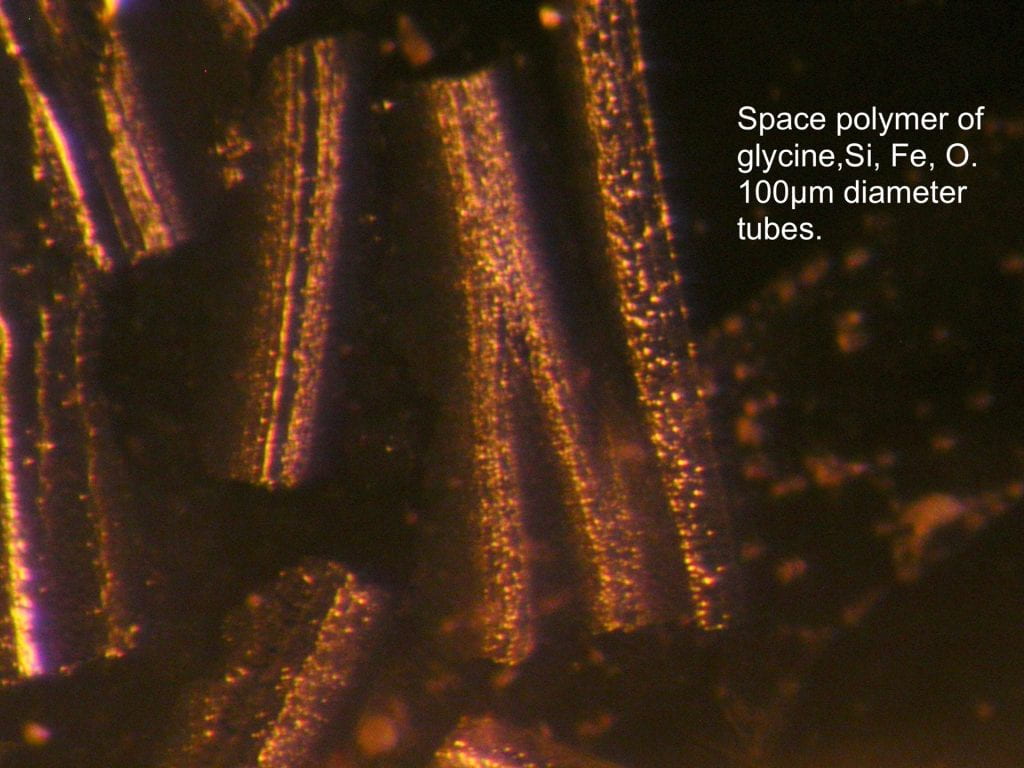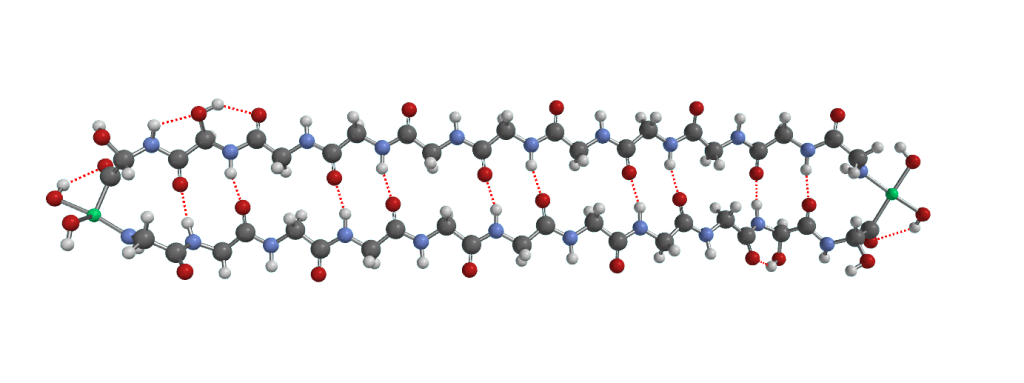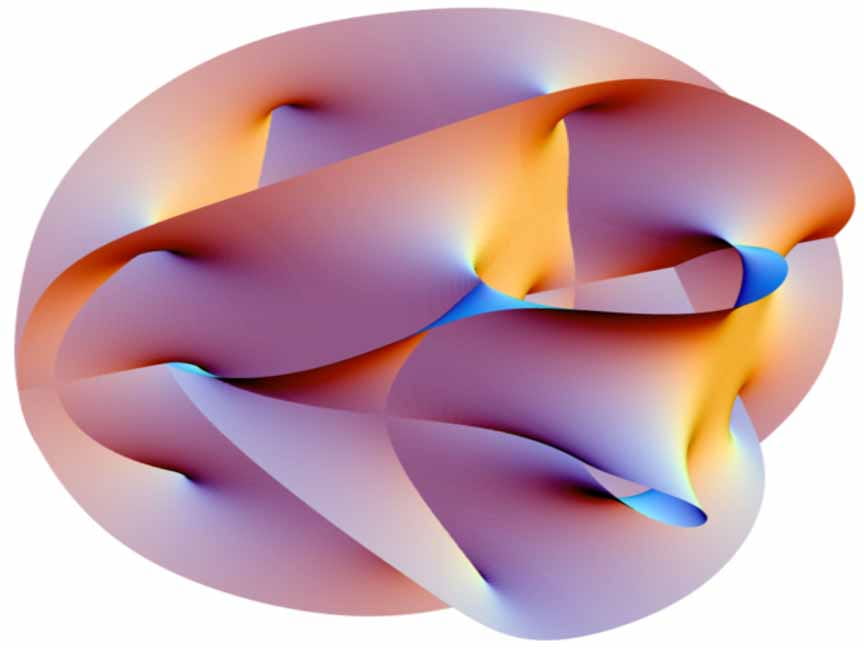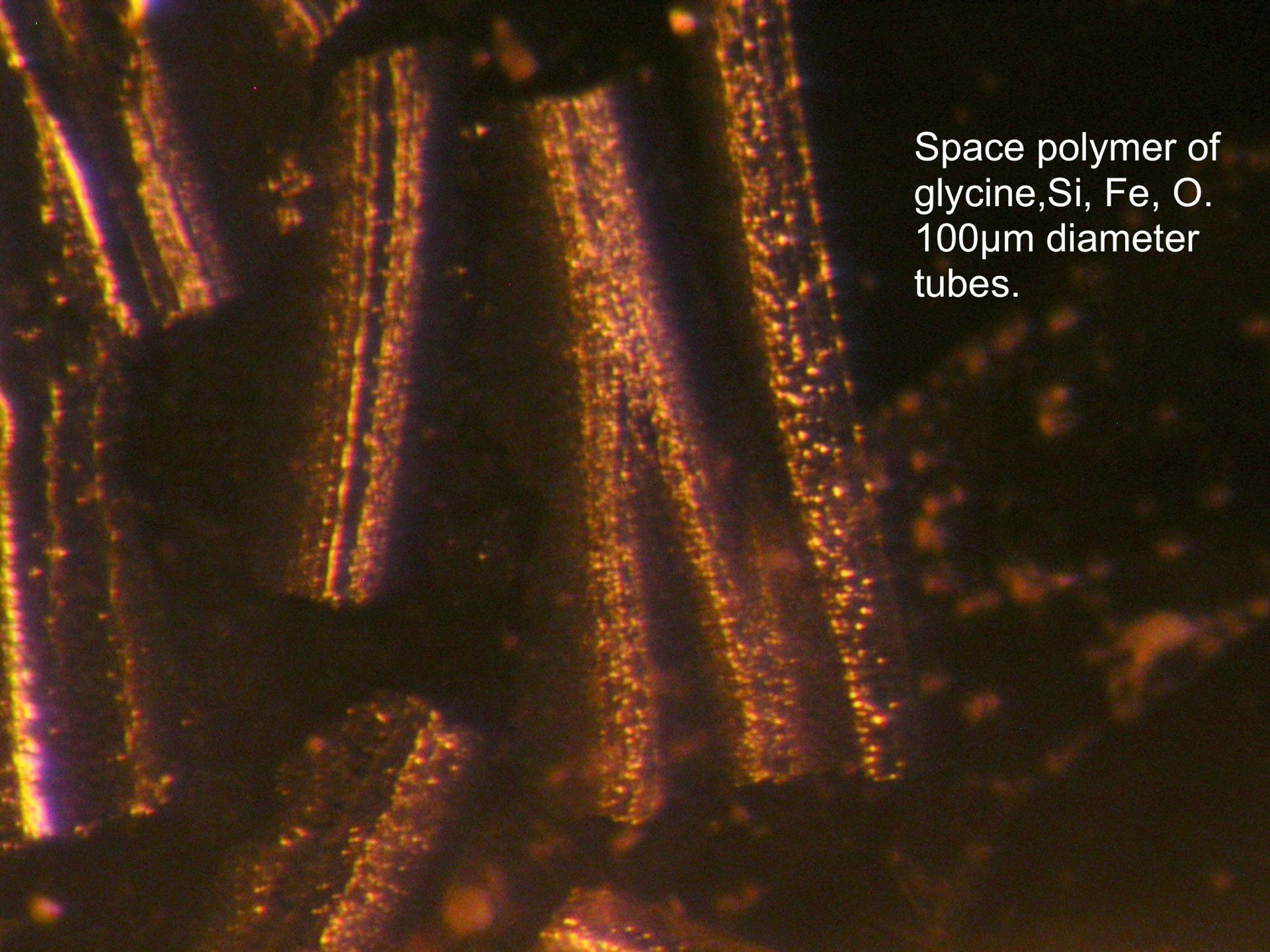Previous McGeoch/Guidotti 1998 ONR/DARPA sensor research

POLYMERS 12.7 GIGA YEARS AGO
Julie E M McGeoch, High Energy Physics DIV, Smithsonian Astrophysical Observatory Center for Astrophysics | Harvard & Smithsonian 60 Garden St, MS 70 Cambridge MA 02138. USA. julie.mcgeoch@cfa.harvard.edu
Department of Molecular and Cellular Biology, Harvard University, 52 Oxford str NW140, Cambridge, MA 02138, USA. mcgeoch@fas.harvard.edu
Our research investigates ancient polymers composed of hydrogen, carbon, nitrogen and oxygen (polymer amides) with Fe, Si, O and Li:
1) Potentially forming the first material topology of the Universe:
Polymer amide as an early topology
Polymer amide in Allende and Murchison meteorites
A 4641 polymer of amino acids in Acfer 086 and Allende meteorites
Polymer amide as a carrier of 15N in Allende and Acfer 086 meteorites
McGeoch M. W., Dikler S. and McGeoch J.E.M. (2020) Hemolithin: A Meteorite Protein containing Iron and Lithium. arXiv:2002.11688 [astro-ph.EP].
McGeoch M. W., Dikler S. and McGeoch J.E.M. (2021) Meteoritic Proteins with Glycine, Iron and Lithium [physics.chem-ph].
McGeoch J. E. M. and McGeoch M. W. (2021) Structural organization of space polymers. arXiv:2104.02731 [cond-mat.soft] Phys. Fluids 33, 067118 (2021)
Julie E. M. McGeoch and Malcolm W. McGeoch. (2022) Chiral 480nm absorption in the hemoglycin space polymer.
Julie E. M. McGeoch and Malcolm W. McGeoch. (2022) Chiral 480nm absorption in the hemoglycin space polymer: a possible link to replication. Submitted to Scientific Reports 9aa2cdea-8831-4e11-8d9e-4a579c3dcd94 | v.1.1
Malcolm W McGeoch, Robin Owen, Sofia Jaho and Julie E M McGeoch (2023) Hemoglycin visible fluorescence induced by X-rays. J. Chem. Phys. 158, 114901 (2023); https://doi.org/10.1063/5.0143945
Julie E M McGeoch., Anton J Frommelt, Robin Owen, Gianfelice Cinque, Arthur McClelland, David Lageson and Malcolm W McGeoch. (2024) Fossil and present-day stromatolite ooids contain a meteoritic polymer of glycine and iron. Submitted & arXiv:2309.17195 [physics.geo-ph]
Julie E. M. McGeoch and Malcolm W. McGeoch (2024) Polymer amide as a source of the cosmic 6.2 micron emission and absorption arXiv:2309.14914 [astro-ph.GA]. MNRAS DOI: 10.1093/mnras/stae756.
Harvard-Heidelberg Workshop October 16-20th 2023. IR absorption of hemoglycin via quantum/experimental/future JWST at 6.2µm.
Cfa SAO ITC Lunchtime talk December 7th 2023. A space polymer of glycine and iron – its potential role in accretion and detection via JWST MIRI at 6.21µm: https://youtube.com/live/fkcuflI7_FI
UPDATE of research on March 22nd 2024
A specific polymer we term HEMOGLYCIN first reported in 2014, has been isolated from asteroid derived meteorite samples. The 1494 Dalton hemoglycin space polymer of Glycine18 Hydroxy-glycine4 Fe2O4 termed the “core unit” is part of a polymer of Glycine, Si, Fe and O that forms tubes, vesicles and a lattice structure isolated from CV3 meteorites and characterized by mass spectrometry, FIB/SIMS and X-ray analysis (at APS Argonne National Laboratory) and the Diamond Light Source UK. In Hartree-Fock calculations the polymer has an absorption of blue light at 480nm that is dependent on rectus “R” (= dextro D) chirality in a hydroxy-glycine residue whose C-terminus is bonded to an iron atom. Experimentally this is now being measured at Avantes CO USA and Diamond Light Source UK. The absorption originates in the Fe II state as a consequence of chiral symmetry breaking. Hemoglycin also absorbs IR light which is important when the polymer is in a molecular cloud, that is not yet a proto-planetary disk with a sun providing visible wavelengths. The polymer core unit could have been selected 4.5 billion years ago in our protoplanetary disc by blue light from the early sun.
Hemoglycin could be responsible for protein on Earth or other planets having S/L chiral amino acids. Hemoglycin can form in R or S chirality within the C-terminus amino acid adjacent to Fe. The 480nm absorption can power a reaction in which water is converted to hydrogen peroxide and the hydroxyglycine is converted back to glycine. The R form is thereby continually destroyed whereas the S form remains available for the production of amino acids through condensation reactions.
Hemoglycin has also been found in fossil and present-day stromatolites and currently other sources are being characterized, based on the fact we know the polymer is arriving on Earth as approximately 1% of the 5,200tons of cosmic dust that arrives on Earth annually. It remains abiotic and on Earth retains raised extraterrestrial 15N:14N in its backbone. D/H is also raised in stromatolites but in other water sources is not raised meaning there is hydrogen exchange in the molecule with Earth hydrogen. The hemoglycin core unit of 1494Da is shown below:

2) Their possible role today in providing an abiotic energy source to stromatolites for CaCO3 accretion. Other systems in biochemistry where CaCO3 is deposited may involve an abiotic association with hemoglycin BUT as yet there is no evidence for this and stromatolites may be the only system still using hemoglcyin.
BACKGROUND FACTS:
The Universe started 13.73±0.12Gyrs ago (chemical time line graph) (Komatsu et al, 2008, Five-year Wilkinson Microwave Anisotropy Probe (WMAP) observations: Cosmological interpretation. Astrophysical J 2008arXiv0803.0547K).
At 500million years from the start of the Universe the constituent elements of polymer amide had formed but not the halogens which in molecular configurations, had they formed at that very early time point, could have readily solubilized polymer amide molecules.
Therefore it follows that in episodes of relatively lower temperature and higher density in the Universe, polymer amide could have formed from Hydrogen, Carbon, Nitrogen and Oxygen, Fe, Si, Li just 500million years after the start of the Universe.
The order of events from the start of the Universe up to the point when polymer amide could in principal have started to form are as follows:
FIRST 500million Years
- Start (BB) at 13.73±0.12Gyrs ago.
- First nucleosynthesis forms hydrogen and helium which are accreted via gravity to form large First Generation (Pop 111) Stars
- Another nucleosynthesis in these stars formed the first 8 elements: H, He, Li, Be, B, C, N, O (Fe, Si, Li, Be & B were very low in amount relative to H, C, N, O). These elements were dispersed outwards when the first stars exploded.
- Molecules could form from chance encounters of these elements at the edge of Pop 111 star dispersal boundaries.
- Potentially the formation of a material topology (via the molecules that the elements could form) would have been a key event in the early molecule survival. Once any material topology arose it would have provided a micro-environment that favoured via confinement further element interactions to form molecules.
- Most importantly water and short stretches of polymer amide might have co-formed* i.e. without polymer amide no bulk water formed and without water no polymer amide formed. This bulk water was explicit water from the condensation reaction during the amide bond formation. Gas phase separate water molecules in space could form and not be dependent on co-formation from polymer amide but the start of “bulk water” might have needed to be tethered by intermolecular hydrogen bonds (water to water and water to amide) to start its bulking process. The polymer acted as a container or surface to allow the tethering. Once some bulk water has formed other separate gas phase water could join or nucleate to the intial explicit water.
The key Universe event is therefore that which allowed the first material topology to arise. In relation to theoretical astrophysics it could also be considered to potentially have provided a material based interface for “String Theory”.
This subject depends on the juxta-positioning of astrophysical theory relating to events 13Gyrs ago and very recent Earth based experimental evidence. Because we had the fortune to observe in 2007 during a very basic experiment involving a pure preparation of an ancient amide, its exceptional properties that immediately suggested to us its early role in the Universe, we are introducing here the predicts of our experimental observations. However this does not mean that these observations in any way prove that proteolipid which is a hydrophobic polymer amide was the first material topology of the Universe. The observations support this hypothesis, because the entrapped water oxygens (by a proteolipid skin) have <1pm of error in their alignment which indicates from chemical, engineering and physics standpoints, a highly significant statistical selection of a system. Further the spacing distance between those oxygens is 3.7Å and slightly at right angles to this, the carbon backbone of the proteolipid skin has also the same 3.7Å spacing. If there was a co-formation of water and polymer amide 13Gyrs ago*, this identical spacing distance within the structure of 2 distinct abuting molecules could indicate the precise structural start point of the co-formation process.
BACKGROUND OBSERVATIONS AND EXPERIMENTAL EVIDENCE:
Water entrapped by a self-replicating membrane of polymer hydrophobic protein has been suggested as the first material based topology of the Universe (McGeoch 2008 Harvard da Vinci Group, May). At those early times it was the formation of the first material before any other existed that was important. Ice nucleation (IN) is discussed as an early accretion process in the Universe, which could either follow after the establishment of the first topology or the data on IN in reality includes ice in a mixed topological configuration i.e. it is not just water but water plus polymer amide.
That a similar system existed when cells first arose on Earth 3.8 Gyrs ago, is supported by evidence that the nucleotide code of one hydrophobic polymer, proteolipid, is the most conserved throughout Archaea, Eubacteria and Eukaria. Water-tight hydrogen bonded beta-sheets of proteolipid can stack as 6Å deep layers around centrally entrapped, ordered water, providing a topology that separates charge, and intermittent alpha-helical configurations confer ion channel function for the transport of cations and water between the layers (McGeoch & McGeoch 2008 J. Roy Soc Interface 5,311-318).). Here we hypothesize that this ancient system of separating charge between insulating layers of hydrophobic protein was incorporated into the first cells as the fundamental component for information storage, later becoming a nervous system. The advent of nucleotide-code-based cell chemistry evolved proteins to interact with this system, some of which suppressed its inclination to self-replicate from a template. Today certain diseases of the nervous system in Homo sapiens involving aggregated beta-sheet protein might have their basis in age-related imperfect transcription/translation or code mutations, rendering the code-based system of control, aberrant. We suggest that Battens (NCL’s), and Alzheimer’s disease might be in this category. The ratio of cell proteolipid mass to its gene codons P1, P2 & P3 translationed product should be higher than that for another control polymer like a skin keratin, if there is ancient template-based self replication for proteolipid, and in Batten’s Disease it should be even higher due to aberrant control of the template system.





